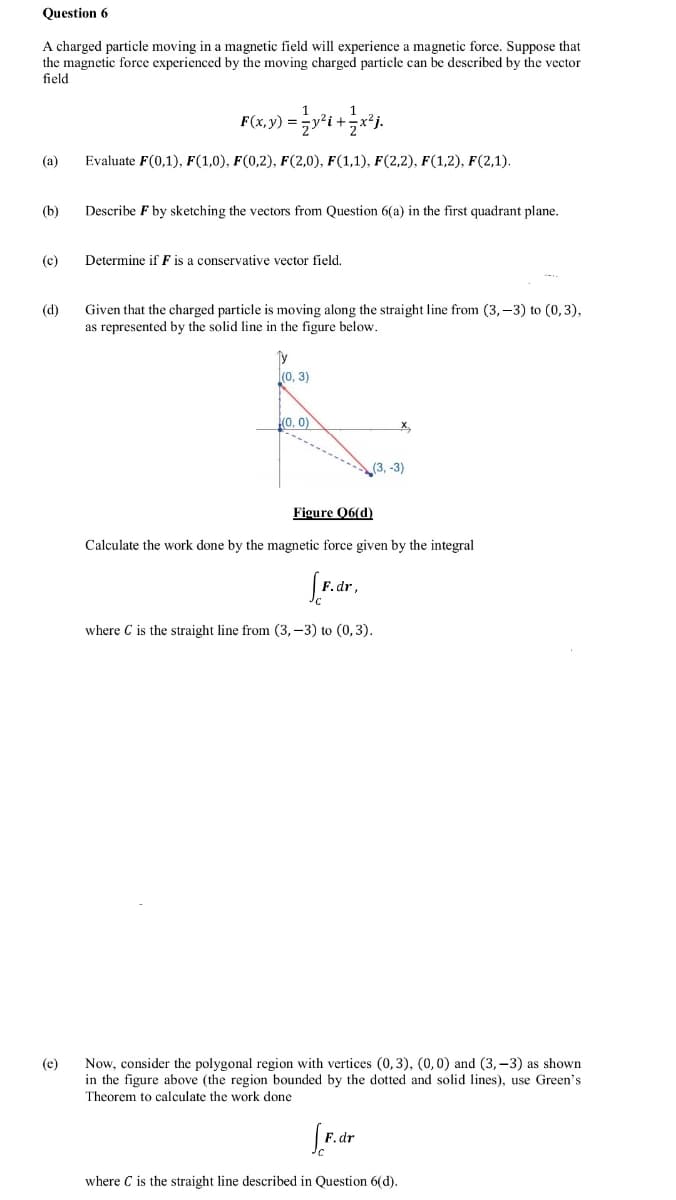A charged particle moving in a magnetic field will experience a magnetic force. Suppose that the magnetic force experienced by the moving charged particle can be described by the vector field F(x,y) = i+ (a) Evaluate F(0,1), F(1,0), F(0,2), F(2,0), F(1,1), F(2,2), F(1,2), F(2,1). (b) Describe F by sketching the vectors from Question 6(a) in the first quadrant plane. (c) Determine if F is a conservative vector field. Given that the charged particle is moving along the straight line from (3,-3) to (0,3), as represented by the solid line in the figure below. (d) (o, 3) (0, 0) x, (3, -3) Figure Q6(d) Calculate the work done by the magnetic force given by the integral where C is the straight line from (3,-3) to (0,3). Now, consider the polygonal region with vertices (0, 3), (0,0) and (3,-3) as shown in the figure above (the region bounded by the dotted and solid lines), use Green's (e) Theorem to calculate the work done where C is the straight line described in Question 6(d).
A charged particle moving in a magnetic field will experience a magnetic force. Suppose that the magnetic force experienced by the moving charged particle can be described by the vector field F(x,y) = i+ (a) Evaluate F(0,1), F(1,0), F(0,2), F(2,0), F(1,1), F(2,2), F(1,2), F(2,1). (b) Describe F by sketching the vectors from Question 6(a) in the first quadrant plane. (c) Determine if F is a conservative vector field. Given that the charged particle is moving along the straight line from (3,-3) to (0,3), as represented by the solid line in the figure below. (d) (o, 3) (0, 0) x, (3, -3) Figure Q6(d) Calculate the work done by the magnetic force given by the integral where C is the straight line from (3,-3) to (0,3). Now, consider the polygonal region with vertices (0, 3), (0,0) and (3,-3) as shown in the figure above (the region bounded by the dotted and solid lines), use Green's (e) Theorem to calculate the work done where C is the straight line described in Question 6(d).
Physics for Scientists and Engineers
10th Edition
ISBN:9781337553278
Author:Raymond A. Serway, John W. Jewett
Publisher:Raymond A. Serway, John W. Jewett
Chapter29: Sources Of The Magnetic Field
Section: Chapter Questions
Problem 8P: One long wire carries current 30.0 A to the left along the x axis. A second long wire carries...
Related questions
Question
Please solve whole question correctly in 2 hour and solve all part's correctly . I will provide you thumbs up if you solve all part's

Transcribed Image Text:Question 6
A charged particle moving in a magnetic field will experience a magnetic force. Suppose that
the magnetic force experienced by the moving charged particle can be described by the vector
field
(a)
Evaluate F(0,1), F(1,0), F(0,2), F(2,0), F(1,1), F(2,2), F(1,2), F(2,1).
(b)
Describe F by sketching the vectors from Question 6(a) in the first quadrant plane.
(c)
Determine if F is a conservative vector field.
Given that the charged particle is moving along the straight line from (3, –3) to (0,3),
as represented by the solid line in the figure below.
(d)
Ty
l(0, 3)
(0, 0)
(3, -3)
Figure Q6(d)
Calculate the work done by the magnetic force given by the integral
where C is the straight line from (3, –3) to (0,3).
Now, consider the polygonal region with vertices (0, 3), (0,0) and (3,-3) as shown
in the figure above (the region bounded by the dotted and solid lines), use Green's
(e)
Theorem to calculate the work done
where C is the straight line described in Question 6(d).
Expert Solution
This question has been solved!
Explore an expertly crafted, step-by-step solution for a thorough understanding of key concepts.
Step by step
Solved in 6 steps with 6 images

Knowledge Booster
Learn more about
Need a deep-dive on the concept behind this application? Look no further. Learn more about this topic, physics and related others by exploring similar questions and additional content below.Recommended textbooks for you

Physics for Scientists and Engineers
Physics
ISBN:
9781337553278
Author:
Raymond A. Serway, John W. Jewett
Publisher:
Cengage Learning

Principles of Physics: A Calculus-Based Text
Physics
ISBN:
9781133104261
Author:
Raymond A. Serway, John W. Jewett
Publisher:
Cengage Learning

Physics for Scientists and Engineers with Modern …
Physics
ISBN:
9781337553292
Author:
Raymond A. Serway, John W. Jewett
Publisher:
Cengage Learning

Physics for Scientists and Engineers
Physics
ISBN:
9781337553278
Author:
Raymond A. Serway, John W. Jewett
Publisher:
Cengage Learning

Principles of Physics: A Calculus-Based Text
Physics
ISBN:
9781133104261
Author:
Raymond A. Serway, John W. Jewett
Publisher:
Cengage Learning

Physics for Scientists and Engineers with Modern …
Physics
ISBN:
9781337553292
Author:
Raymond A. Serway, John W. Jewett
Publisher:
Cengage Learning


Physics for Scientists and Engineers: Foundations…
Physics
ISBN:
9781133939146
Author:
Katz, Debora M.
Publisher:
Cengage Learning

College Physics
Physics
ISBN:
9781938168000
Author:
Paul Peter Urone, Roger Hinrichs
Publisher:
OpenStax College